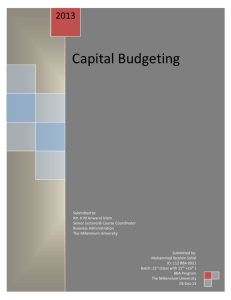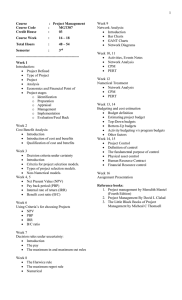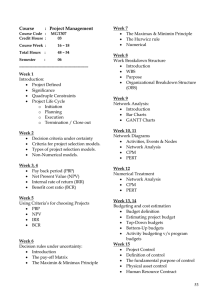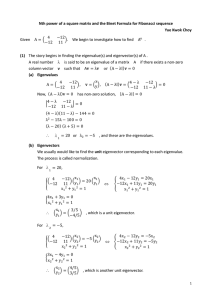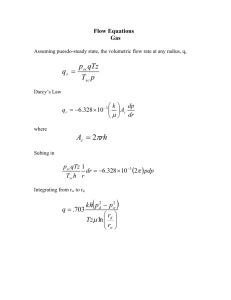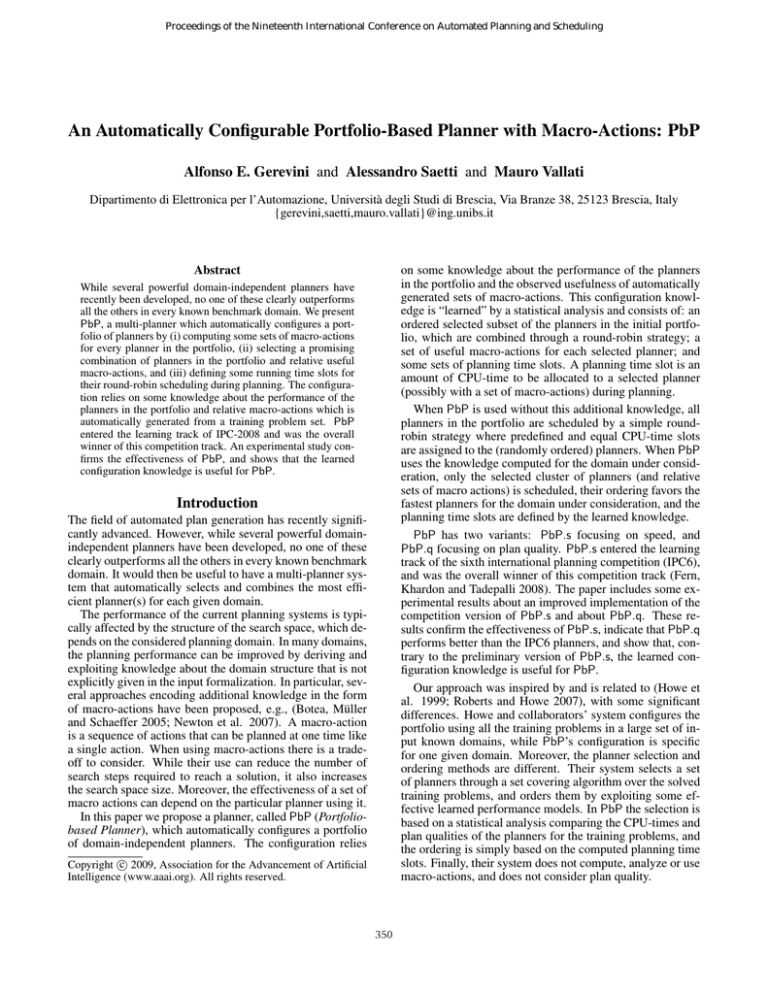
Proceedings of the Nineteenth International Conference on Automated Planning and Scheduling
An Automatically Configurable Portfolio-Based Planner with Macro-Actions: PbP
Alfonso E. Gerevini and Alessandro Saetti and Mauro Vallati
Dipartimento di Elettronica per l’Automazione, Università degli Studi di Brescia, Via Branze 38, 25123 Brescia, Italy
{gerevini,saetti,mauro.vallati}@ing.unibs.it
on some knowledge about the performance of the planners
in the portfolio and the observed usefulness of automatically
generated sets of macro-actions. This configuration knowledge is “learned” by a statistical analysis and consists of: an
ordered selected subset of the planners in the initial portfolio, which are combined through a round-robin strategy; a
set of useful macro-actions for each selected planner; and
some sets of planning time slots. A planning time slot is an
amount of CPU-time to be allocated to a selected planner
(possibly with a set of macro-actions) during planning.
When PbP is used without this additional knowledge, all
planners in the portfolio are scheduled by a simple roundrobin strategy where predefined and equal CPU-time slots
are assigned to the (randomly ordered) planners. When PbP
uses the knowledge computed for the domain under consideration, only the selected cluster of planners (and relative
sets of macro actions) is scheduled, their ordering favors the
fastest planners for the domain under consideration, and the
planning time slots are defined by the learned knowledge.
PbP has two variants: PbP.s focusing on speed, and
PbP.q focusing on plan quality. PbP.s entered the learning
track of the sixth international planning competition (IPC6),
and was the overall winner of this competition track (Fern,
Khardon and Tadepalli 2008). The paper includes some experimental results about an improved implementation of the
competition version of PbP.s and about PbP.q. These results confirm the effectiveness of PbP.s, indicate that PbP.q
performs better than the IPC6 planners, and show that, contrary to the preliminary version of PbP.s, the learned configuration knowledge is useful for PbP.
Our approach was inspired by and is related to (Howe et
al. 1999; Roberts and Howe 2007), with some significant
differences. Howe and collaborators’ system configures the
portfolio using all the training problems in a large set of input known domains, while PbP’s configuration is specific
for one given domain. Moreover, the planner selection and
ordering methods are different. Their system selects a set
of planners through a set covering algorithm over the solved
training problems, and orders them by exploiting some effective learned performance models. In PbP the selection is
based on a statistical analysis comparing the CPU-times and
plan qualities of the planners for the training problems, and
the ordering is simply based on the computed planning time
slots. Finally, their system does not compute, analyze or use
macro-actions, and does not consider plan quality.
Abstract
While several powerful domain-independent planners have
recently been developed, no one of these clearly outperforms
all the others in every known benchmark domain. We present
PbP, a multi-planner which automatically configures a portfolio of planners by (i) computing some sets of macro-actions
for every planner in the portfolio, (ii) selecting a promising
combination of planners in the portfolio and relative useful
macro-actions, and (iii) defining some running time slots for
their round-robin scheduling during planning. The configuration relies on some knowledge about the performance of the
planners in the portfolio and relative macro-actions which is
automatically generated from a training problem set. PbP
entered the learning track of IPC-2008 and was the overall
winner of this competition track. An experimental study confirms the effectiveness of PbP, and shows that the learned
configuration knowledge is useful for PbP.
Introduction
The field of automated plan generation has recently significantly advanced. However, while several powerful domainindependent planners have been developed, no one of these
clearly outperforms all the others in every known benchmark
domain. It would then be useful to have a multi-planner system that automatically selects and combines the most efficient planner(s) for each given domain.
The performance of the current planning systems is typically affected by the structure of the search space, which depends on the considered planning domain. In many domains,
the planning performance can be improved by deriving and
exploiting knowledge about the domain structure that is not
explicitly given in the input formalization. In particular, several approaches encoding additional knowledge in the form
of macro-actions have been proposed, e.g., (Botea, Müller
and Schaeffer 2005; Newton et al. 2007). A macro-action
is a sequence of actions that can be planned at one time like
a single action. When using macro-actions there is a tradeoff to consider. While their use can reduce the number of
search steps required to reach a solution, it also increases
the search space size. Moreover, the effectiveness of a set of
macro actions can depend on the particular planner using it.
In this paper we propose a planner, called PbP (Portfoliobased Planner), which automatically configures a portfolio
of domain-independent planners. The configuration relies
c 2009, Association for the Advancement of Artificial
Copyright Intelligence (www.aaai.org). All rights reserved.
350
Planning
Authors, date
Helmert, 2006
Hoffmann & Nebel, 2001
Gerevini, Saetti & Serina, 2005
Botea, Enzenberger, Müller & Schaeffer, 2005
Coles & Smith, 2007
Chen, Wah & Hsu, 2006
Vidal, 2004
Portfolio configuration
Planner
Fast Downward
Metric-FF
LPG-td
MacroFF
Marvin
SGPlan5
YAHSP
Table 1: Domain-independent planners currently in PbP.
In the rest of the paper, first we describe PbP and then we
present the experimental results.
The Portfolio-based Planner (PbP)
Domain and
problem to solve
Multi-planner by
round-robin scheduling
Solution plan
or failure
Cluster of planners with macros
Planning time
slots computation
Time slots
Planner cluster
selection & ordering
Planners with
macros
Macro-actions
computation
Wizard
Domain and
training probs
MacroFF
Planners
Figure 1: A sketch of PbP’s architecture.
In this section, we give an overview of PbP’s architecture
and of the proposed implemented methods for selecting a
cluster of planners and macro-actions for an input domain.
robin scheduling algorithm using the computed planning
time slots. Concerning termination of the resulting multiplanner, PbP.s is interrupted if either a given CPU-time limit
T is exceeded (returning failure), or one among the selected
planners computes a solution (output of PbP.s). PbP.q’s
execution is interrupted if either time T is exceeded, or all
the selected planners terminate. If PbP.q generates no solution within T , it returns failure; otherwise it returns the best
computed solution.
The PbP Architecture
Table 1 shows the seven planners currently integrated into
PbP. The architecture of PbP, sketched in Figure 1, consists
of four main components, which are briefly described below.
Algorithms for computing macro-actions. For each integrated planner, PbP computes some sets of macro-actions
using Wizard (Newton et al. 2007) and the techniques described in (Botea, Müller and Schaeffer 2005). With the
first, PbP produces at most two alternative sets of plannerindependent macro-actions; with the second, it produces at
most five sets of alternative macro-actions for MacroFF.
Algorithms for computing the planning time slots of each
considered planner. For each integrated planner, PbP defines the planning time slots as the CPU-times used to solve
the following percentages of problems during the learning
phase: {25, 50, 75, 80, 85, 90, 95, 97, 99}. A similar method
is also used in (Roberts and Howe 2007), but with the technical difference explained in the following example. Assume that the computed planning time slots for planner A
are {0.20, 1.40, 4.80, 22.50, . . . } and that those for planner
B are {14.5, 150.8, . . . }. Then, for this pair of planners,
PbP extends the first time slot for A (0.20) to 4.80, i.e., to
the greatest time slot of A which is smaller than the first
time slot of B; similarly for the subsequent time slots. If
the first time slot of A were not extended, the slowest planner B would initially run for a CPU-time much greater than
the CPU-time initially assigned to the fastest planner A, and
for many problems that planner A quickly solves (e.g., using
one CPU-seconds), PbP would perform significantly slower.
Algorithms for selecting a cluster of planners using a (possibly empty) set of macro-actions and for ordering their runs.
PbP runs each integrated planner with and without a set of
computed macro-actions. Then, it selects a cluster of planners in the initial portfolio, each one with a (possibly empty)
set of useful macro-actions. Moreover, the execution order
of the planners in the selected cluster is defined by the increasing CPU-time slots associated with the planners. More
on this in the next section of the paper.
Algorithms for the planner scheduling and plan generation. PbP runs the selected ordered planners (each one using the relative selected set of macro-actions) by a round-
Selecting a Cluster of Planners and Macro-actions
At configuration time, for each given test domain, PbP considers the execution of all the integrated planners, and selects
a subset of them on the basis of their observed performance
for a training problem set in the domain. In PbP, the performance measure considers either the CPU-time (PbP.s) or
the plan quality (PbP.q).
After having run each planner with every computed set of
macro-actions (one run for each set) for the training problem
set of a domain D, PbP analyzes the results (CPU-times and
plan qualities) to identify the best cluster of planners and
macro-actions for D. This is done by simulating, for each
cluster C of at most k planners with a (possibly empty) set of
macro-actions, the round-robin execution of the planners in
C for solving the same training problems.1 The simulation
is conducted using the data from the previous runs, and the
simulated performances of the clusters are compared by a
statistical analysis based on the Wilcoxon sign-rank test.2
The data for carrying out the test in PbP.s are derived
as follows. For each planning problem, the system computes the difference between the simulated execution times
of the compared clusters. If a planner cluster does not solve
a problem, the corresponding simulated time is twice the
CPU-time limit (15 minutes, as in IPC6); if no cluster solves
the problem, this problem is not considered. The difference
between the simulated times is normalized by the value of
the best simulated time under comparison (e.g., if cluster C1
requires 200 seconds and cluster C2 220, then the difference is 10% in favour of C1 ). The absolute values of these
k is a parameter that in our experiments was set to 3.
The Wilcoxon test has also been used in (Long and Fox 2003;
Gerevini et al. 2009; Roberts and Howe 2009), but for different purposes. The first two papers contain details about the test
and a discussion on its adequateness for comparing planner performances.
1
2
351
Domain
D1
D2
D3
D4
D5
D6
PbP.s
YAHSP (63)
FD (–) + YAHSP (14.3)
SGPlan5 (50)
YAHSP (0)
FD (–) + YAHSP (–)
MFF (20)
PbP.q
SGPlan5 (33) + LPG (100) + FF (33)
FD (–) + YAHSP (86) + LPG (0)
FD (–) + MFF (20) + LPG (100)
Marvin (0) + FF (0) + YAHSP (0)
FD (–) + FF (–) + Marvin (–)
YAHSP (100) + MFF (40) + Marvin (–)
Planner
CABALA
DAE1
DAE2
MacroAltAlt
ObtuseWedge
PbP.s
PbP.q
REPLICA
RFA1
RFA2
Roller
Sayphi-Rules
Wizard+FF
Wizard+SGPlan
Table 2: Planner clusters and percentages of macros (in
round brackets) selected by PbP for the IPC6 domains
Gold-miner (D1), Matching-BW (D2), Sokoban (D3),
Parking (D4), Thoughful (D5) and N-puzzle (D6). FD
and MFF abbreviate Fast Downward and MacroFF.
differences are then ranked by increasing numbers, starting
from the lowest value. The ranks of the positive differences
and the ranks of the negative differences are summed, yielding two values r+ and r− , respectively. If the performance
of the two compared clusters is not significantly different,
then r+ and r− are similar. Intuitively, the test considers a
weighted sum of the number of times a cluster performs better than the other compared one. The method used by PbP.q
is similar, but it applies to the plan qualities resulting from
the cluster execution simulation.
The Wilcoxon test is characterised by a probability value
p, which represents the level of significance of the performance gap. PbP uses a default confidence level equal to
99.9%; hence, if p is greater than 0.001, then the hypothesis that the performance of the compared sets of planners is
statistically similar is refused, and the alternative hypothesis
that their performance is statistically different is accepted.
The results of the Wilcoxon test are used to form a directed graph where the nodes are the compared clusters,
and an edge from a cluster C1 to another cluster C2 indicates that C1 performs better than C2 . Each strongly connected component of this graph is collapsed into a single
node representing the elements in the clusters of the collapsed nodes. From the resulting DAG, PbP considers only
the nodes without incoming edges (the graph root nodes). If
there is only one root node, this is the selected cluster, otherwise PbP uses some secondary criteria to select the most
promising cluster among the root nodes. These criteria include the number of solved problems, the sums of the ratios
between the (simulated) CPU-times of the planners in the
compared clusters, and the first planning CPU-time slots of
the involved planners. Table 2 shows the clusters of planners
and the relative percentages of macros selected by PbP for
each IPC6 domain (Fern, Khardon and Tadepalli 2008).
Solved (%)
1.67
18.3
18.3
28.9
65.0
90.0
93.0
31.7
47.2
26.1
30.6
26.1
56.7
51.1
Time
0.004
0.007
0.012
4.458
76.54
107.9
8.759
6.910
14.15
3.864
7.667
3.312
40.16
36.58
Quality
2.50
31.7
31.4
44.9
89.7
117
151
24.1
61.5
34.4
24.2
28.7
88.4
76.3
Table 3: Percentages of solved problems within the IPC6
CPU-limit (15 min), scores for the time and plan quality of
the planners that took part in the learning track of IPC6.
Planner
Lama
PbP.s
PbP.q
Solved (%)
75.6
90.0
92.8
Time
13.6
159.7
28.3
Quality
126.2
108.5
141.8
Table 4: Percentages of solved problems, time and quality
scores (competition evaluation functions) of Lama and PbP.
for improving PbP’s performance. The experimental tests
were run on a machine slightly slower than the one used for
IPC6. The CPU-time limit was the same as in IPC6.
PbP versus the IPC6 Planners
Table 3 compares PbP with the learned configuration knowledge and the planners that entered the learning track of IPC6
in terms of percentage of solved problems, time and plan
quality.3 The performance scores in Table 3 were obtained
by the same simple evaluation scheme used in IPC6. If a
planner P solves a problem π with time T (with plan quality Q), it gets a score equal to T ∗ /T (Q∗ /Q), where T ∗ is
the best time required by the compared planners to solve π
(Q∗ is the smallest number of actions in the plans computed
for π); otherwise, it gets zero score. The time (quality) score
for planner P is the sum of the time (quality) scores assigned
to P over all the competition problems. The results in Table
3 indicate that the new version of PbP.s performs much better than the IPC6 planners (PbP.s solves many more problems, and also has much greater time and quality scores) and
that PbP.q is clearly the best planner in terms of plan quality. The time score of PbP.q is low because PbP.q stops
only when all the selected planners terminate or the CPUtime limit is exceeded. Moreover, we observed that PbP.s/q
has much better time/quality scores than those of every integrated planner.
Table 4 compares the performances of the multiplanner in
PbP.s and PbP.q (with the learned knowledge) w.r.t. Lama,
the winner of the IPC6 classical track, for the benchmark
problems of the IPC6 learning track. PbP.s solves many
more problems and is generally much faster than Lama.
Experimental Results
The preliminary implementation of PbP.s that entered the
learning track of IPC6 contains some implementation bugs
and uses some inefficient Linux shell scripts. We have fixed
these bugs and implemented a new version of PbP.s completely in C. Unless otherwise specified, in the following
PbP.s denotes the newer version.
In this section, we present the results of an experimental
study about PbP with three main goals: (i) confirming the
efficiency of PbP.s; (ii) evaluating the efficiency of PbP.q in
terms of plan quality by comparing it with other IPC6 planners, (iii) testing the effectiveness of the learned knowledge
3
The IPC6 test problem set and training problem set are different. These problems and a collection of short papers on the evaluated planners can be found in (Fern, Khardon and Tadepalli 2008).
352
Planner
DAE1
DAE2
MacroAltAlt
ObtuseWedge
PbP.s
PbP.q
Sayphi-Rules
Wizard+FF
Wizard+SGPlan
ΔSolved (%)
+0.2
+0.1
+1.1
+17.3
+1.7
+2.8
+0.0
−6.6
−1.7
ΔTime
+0.0
−0.0
+0.12
+33.6
+84.2
+8.99
−11.8
+18.4
+15.0
Solved problems (%)
100
PbP.s +k (time)
PbP.s nok (time)
80
PbP.s +k (%solved)
PbP.s nok (%solved)
ΔQuality
+29.6
+15.2
−0.1
+27.7
−10.8
+2.0
−8.8
−16.3
−2.9
Seconds
900
720
60
540
40
360
20
180
0
0
5
Table 5: Performance gaps between the IPC6 planners
with/out learned knowledge in terms of % of solved problems, time and quality scores. The planners that, according
to the IPC6 results, work only with knowledge are omitted.
10
15
20
25
30
35
Number of crates
40
45
50
Figure 2: Percentage of solved problems (Depots domain) and average CPU-time (log. scale) of PbP.s with/out
(+k/nok) the learned knowledge.
PbP.s performs worse in terms of plan quality, but this is not
surprising because Lama searches for good quality plans,
while PbP.s focuses on speed. Interestingly, PbP.q solves
more problems than Lama and performs better in terms of
plan quality.
PbP.q
+k
nok
5
21.6
21.7
10
40.5
40.9
15
62.3
63.2
20
88.5
101
25
118
140
30
174
191
35
194
213
Table 6: Average number of actions in the plans computed by PbP.q using the learned knowledge (“+k” line) and
PbP.q without the knowledge (“nok” line) for Depots.
On the Effectiveness of the Learned Knowledge
problem, while PbP.q with knowledge solves many problems (e.g., 62% with 40 crates); for the solved problems
with more than 15 crates, on average, PbP.q with knowledge computes much better plans.
Table 5 shows the performance gap of PbP and other IPC6
planners with and without the learned knowledge for the
IPC6 test problems (positive values are improvements obtained by using learned knowledge). For PbP.s, the learned
knowledge is very helpful in terms of speed, while it does
not help to improve plan quality (but this is not surprising
since this knowledge is generated ignoring plan quality).
It is important to note that, contrary to these results, the
learned knowledge does not speedup the competition version
of PbP.s for the IPC6 problems. This behaviour, observed
by the IPC6 organizers, depends on some implementation
bugs concerning both the learning phase and the planning
phase, and on the inefficient use of some Linux shell scripts
(evident especially for small or easy problems).
The results in Table 5 indicate that the use of the learned
knowledge in PbP gives only small improvements in terms
of solved problems and plan quality (using PbP.q) within
the considered CPU-time limit. However, with this limit,
many IPC6 problems are inadequate to observe possible
plan-quality and problem-solved improvements in PbP, because they can be quickly (relative to the limit) solved by
most of the incorporated basic planners, and incrementally
optimized by LPG.
In order to better understand the effectiveness of using the learned configuration knowledge in terms of solved
problems and plan quality, we conducted an additional experiment using a set of large problems in the well-known
Depots domain. Every marked point on the curves of Figure 2 is the average value (time or % of solved problems)
over 100 randomly generated Depots problems with 7 locations, 3 trucks, 7 hoists and the number of crates indicated over the x-axis. For this class of problems, PbP.s with
knowledge performs significantly better w.r.t. the number
of solved problems and planning speed. Finally, Table 6
shows the quality of the plans computed by PbP.q with/out
knowledge for the set of large Depots problems, which
only few incorporated planners solve within the limit. For
more than 35 crates, PbP.q without knowledge solves no
Conclusions
We have presented PbP, a planner based on an automatically configurable portfolio of domain-independent planners, which can compute and exploit additional knowledge
about a given planning domain specified with PDDL. An
experimental study shows that PbP.s performs better than
the planners that entered the learning track of IPC6, that the
knowledge learned by PbP.s can improve the efficiency of
our approach significantly, and finally that for a collection
of large problems the knowledge learned by PbP.q is very
effective. Future work includes additional experiments and
the extension of PbP to integrate further recent planners.
References
Botea, A.; Müller, M.; and Schaeffer, J. 2005. Learning PartialOrder Macros from Solutions. In Proc. of ICAPS-05.
Fern, A.; Khardon, R.; and Tadepalli, P. 2008. 6th IPC – Learning
Track http://eecs.oregonstate.edu/ipc-learn/
Gerevini, A.; Haslum, P.; Long, D.; Saetti, A.; and Dimopoulos,
Y. 2009. Deterministic Planning in the Fifth International Planning Competition: PDDL3 and Experimental Evaluation of the
Planners. Artificial Intelligence, 173(5-6): 619–668.
Howe, A; Dahlman, E.; Hansen, C.; vonMayrhauser, A.; and
Scheetz, M. 1999. Exploiting Competitive Planner Performance.
In Proc. of 5th European Conf. on Planning (ECP-99).
Long, D.; and Fox, M. 2003. The 3rd International Planning
Competition: Results and Analysis, JAIR, 20:1–59
Newton, M.; Levine, J.; Fox, M.; and Long, D. 2007. Learning
Macro-Actions for Arbitrary Planners and Domains. In ICAPS07.
Roberts, M.; and Howe, A. 2007. Learned Models of Performance for Many Planners. In Proc. of ICAPS’07 Workshop of AI
Planning and Learning.
Roberts, M.; and Howe, A. 2009. Learning from planner performance. Artificial Intelligence, 173(5-6):536-561.
353

